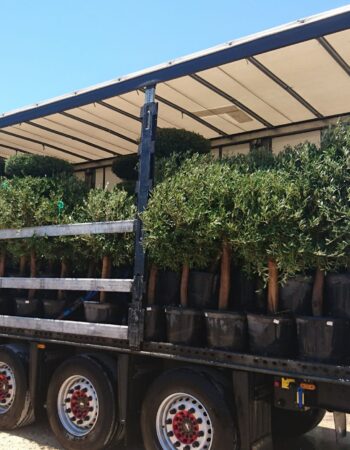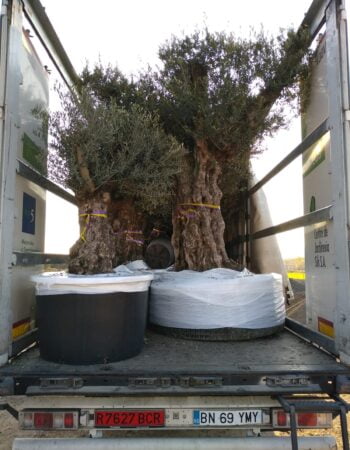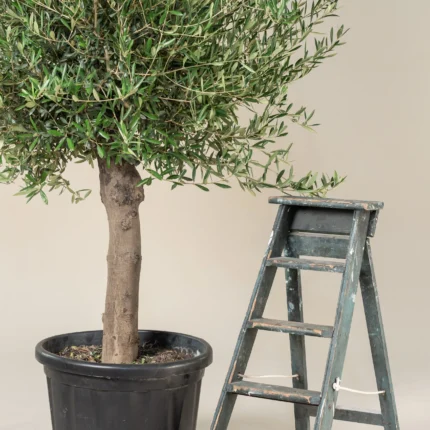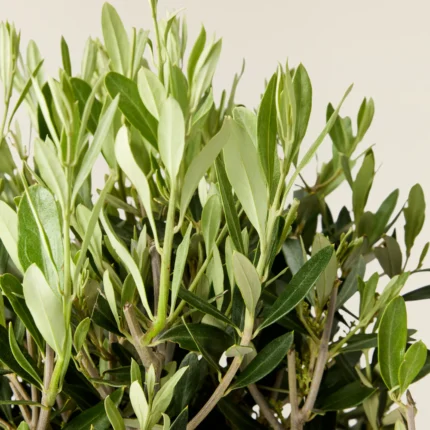Olea Europaea «Minibonsai»
The Olea europaea ‘Minibonsai’ is a miniature cultivar of the classic Olive Tree, designed to bring the charm of traditional olive trees into a compact form. Perfect for bonsai enthusiasts and those with limited space, this variety retains the distinctive features of the Olive Tree but in a much smaller, more manageable size. Its delicate foliage, small stature, and intricate form make it an ideal choice for indoor settings, small gardens, and decorative displays.
- Botanical Name: Olea europaea ‘Minibonsai’
- Common Name: Miniature Olive Tree, Minibonsai Olive
- Mature Height: 6-12 inches (0.15-0.30 meters) can be maintained at a smaller size with pruning
- Mature Spread: 4-8 inches (0.10-0.20 meters)
- Growth Rate: Slow
- Light Requirements: Bright, indirect light; can tolerate some direct sunlight
- Soil Requirements: Well-draining soil; prefers a mix suitable for bonsai, such as a blend of akadama, pumice, and lava rock
- Water Needs: Moderate; prefers consistently moist soil but can tolerate brief dry periods
- Foliage: Evergreen, lance-shaped leaves with a silvery-green color and a leathery texture
- Trunk: Miniature and often carefully shaped to enhance the bonsai aesthetic
Uses:
- Ornamental: Adds a unique and elegant touch to indoor spaces, small gardens, and decorative displays.
- Bonsai Art: Ideal for bonsai enthusiasts looking to create intricate and miniature olive tree designs.
- Container Planting: Perfect for growing in small pots or containers, making it suitable for balconies, patios, and indoor environments.
Benefits:
- Compact Size: The small stature makes it ideal for limited spaces and indoor settings.
- Aesthetic Appeal: The miniature form and delicate foliage provide a refined and charming appearance.
- Low Maintenance: Requires minimal care compared to larger olive trees and adapts well to indoor conditions.
- Long-Lasting: With proper care, the Minibonsai Olive Tree can thrive for many years, offering a lasting decorative feature.
The Olea europaea ‘Minibonsai’ is a delightful and compact version of the classic Olive Tree, perfect for adding a touch of Mediterranean charm to any space. Its miniature size, coupled with its ornamental value and low maintenance requirements, makes it an excellent choice for both bonsai enthusiasts and those seeking a unique indoor plant.
Debes acceder para publicar una valoración.


CAREFUL TREE TRANSPORTATION
At Treezom, we take great care in transporting your trees to ensure they arrive in perfect condition. Our expert team uses various methods, depending on the size and volume of the order, to provide safe and efficient delivery. Whether you're ordering a single tree or a bulk order, we guarantee high standards of handling and care throughout the process.
MULTIPLE SHIPPING METHODS
- Truck Delivery: Ideal for local or regional deliveries, ensuring a smooth and timely shipment of your trees directly to your location.
- Sea Containers (20’ or 40’): Perfect for larger orders or international shipping. Our sea containers are equipped to handle bulk shipments with optimal protection.
- Other Customized Solutions: Depending on the size and nature of your order, we can offer tailored shipping methods to meet your specific needs.
No matter the shipping method, we use specialized packaging and handling procedures to protect the trees during transit, ensuring they arrive healthy and ready for planting.
Below, you’ll find key tips tailored to this species’ requirements. Whether you’re new to plant care or have plenty of experience, these guidelines are here to support you in keeping your green companion healthy and vibrant.
- Planting:
- Use a well-draining bonsai soil mix to ensure proper aeration and drainage.
- Choose a location with bright, indirect light or a sunny spot if indoors.
- Watering:
- Water regularly to keep the soil consistently moist, but avoid waterlogging.
- Allow the top layer of soil to dry out slightly between waterings.
- Pruning:
- Regular pruning is essential to maintain the desired shape and size.
- Prune in late winter or early spring before new growth begins, and trim as needed throughout the growing season.
- Fertilizing:
- Apply a balanced, slow-release bonsai fertilizer in early spring and mid-summer.
- Follow the manufacturer’s instructions for application rates.
- Pest and Disease Control:
- Monitor for pests such as spider mites, scale insects, and aphids.
- Use appropriate treatments to manage infestations.
- Ensure good air circulation and avoid overwatering to prevent fungal diseases.
*This information is provided for informational purposes only. For more detailed care, please consult a professional Gardener or Arborist.


 SINGLE TREE
SINGLE TREE OUTDOOR POTS
OUTDOOR POTS

















 Single Tree
Single Tree
Valoraciones
No hay valoraciones aún.